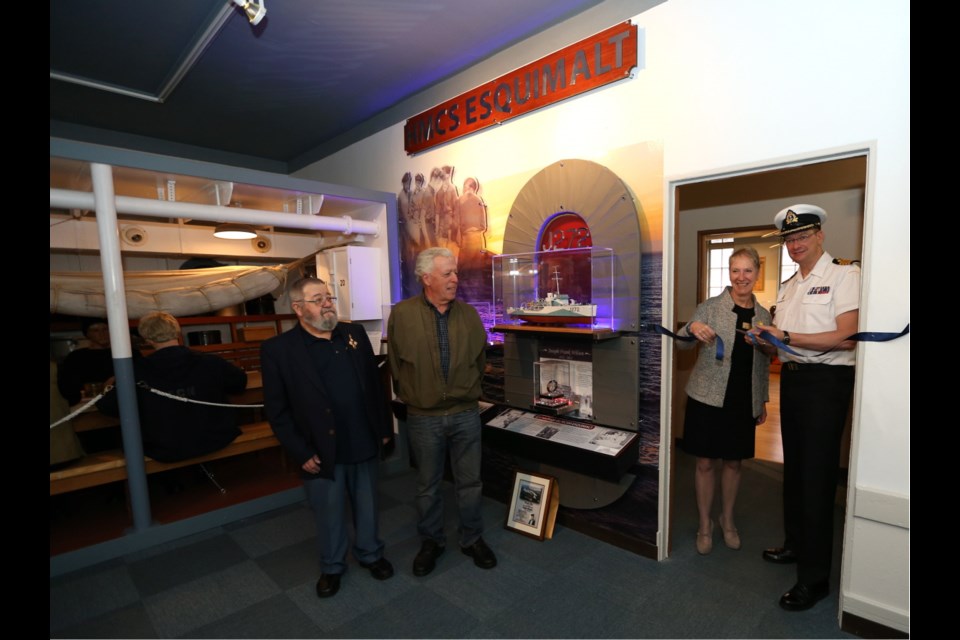Retired electrical engineer Ralph Zbarsky donated more than 40 Second World War letters written by his uncle to the Naval Museum at CFB Esquimalt on Friday.
But Zbarsky will keep the one postmarked April 16, 1945, the day his Uncle Ralph died when his ship, HMCS Esquimalt, was torpedoed and sank less than 24 hours after leaving Halifax for an anti-submarine patrol. The uncle was 21 and sent the letter to his parents.
The letter has never been opened or read and Zbarsky said he has no plans to violate that trust. It was left unopened by both his grandparents in Saskatchewan and later by his own father. It will remain in the family as a reminder of a life sacrificed and never completed.
“He [Uncle Ralph] volunteered when he was 17 and he lost his life, and it was such a tragedy that it was never dealt with by the family in any depth,” said Zbarsky, of Vancouver.
Zbarsky was one of about 20 people on hand at the CFB Esquimalt Naval and Military Museum on Friday to officially open a new, permanent exhibit and tribute to the ship that bore the community name, HMCS Esquimalt.
The vessel sank 71 years ago today, making it the last Canadian vessel sunk in the war. Of the 71-strong crew, 44 were killed.
Also unveiled on Friday at the museum were illustrative panels prepared by the Royal B.C. Museum on the First World War. The exhibit is meant to travel the province.
The new permanent exhibit contains models of the ship and a model and artifacts from the German U-boat, U-190, that sank her. The German boat surrendered to the Canadian Navy on May 11, 1945, after the German surrender.
Also in the museum’s HMCS Esquimalt exhibit is a mock-up of a below-decks mess space. It gives an idea of living conditions for ordinary sailors on naval vessels during the Second World War.
Other exhibits include a mock-up of sailors wrestling anti-submarine explosive depth-charges into place, a command bridge, and scale models of ships, submarines and planes used over the sea during the war and later.
Base Commander Capt. (N) Steve Waddell, said the exhibit and the whole naval museum will always be a connection to history, traditions and navy people who served before him.
“So it’s always really fitting for me to take a moment from time to time in my workday to come down and look and read and make that connection,” Waddell said.
Lorne Hammond, curator of history for the Royal B.C. Museum, opened a First World War exhibit panel with stories unique to B.C. One such story is the delightful tale of the provincial government’s purchase in 1914 of two submarines from a Seattle shipyard, where they had been built for Chile, which never paid for them. The two boats, CC1 and CC2, were later presented to the federal government in Ottawa for use in the war and were the first submarines to serve in the Canadian Navy.
“I would have loved to hear that telephone call to Ottawa: ‘Hello, I’ve got two submarines for you,’ ” said Hammond.
Small museums, like the Naval Museum at CFB Esquimalt, are vital repositories of local history, he said.
“These small museums are the heart and soul of a community. The curators are the heritage workers who work for us all, sometimes with no budget whatsoever.”
He applauded small museums for the role they play in welcoming new arrivals and residents into any community.
“They always lend a sense of place to a community and can really help with the decompression of new arrivals,” said Hammond.
The CFB Esquimalt Naval and Military Museum is open to the public, weekdays, 10 a.m. to 3:30 p.m. It is closed on holidays and most weekends. Suggested donations are adults, $2, children, $1 and families, $5.
For more information, go to navalandmilitarymuseum.org.



